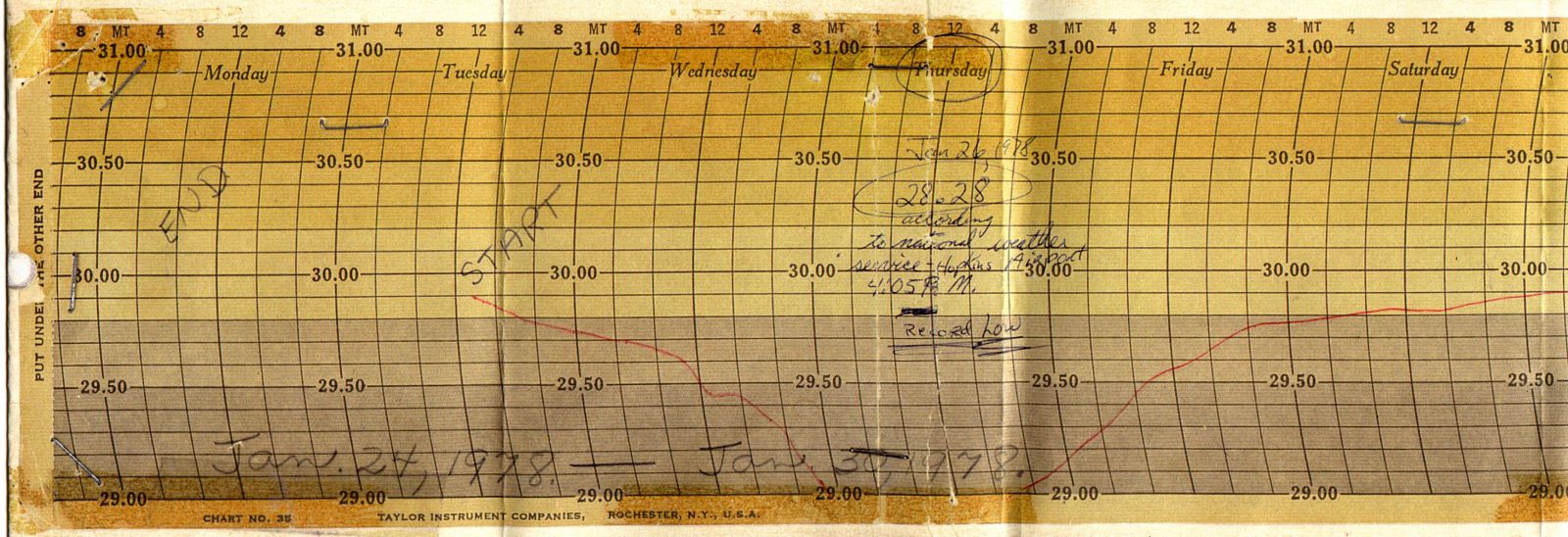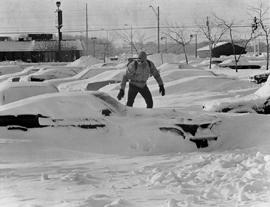Storm
From Page A1
most of the day, reaching 69 miles an hour at Dayton and Columbus and 75 at Akron (Blackburn 1978). A wind gust to 82 miles an hour at Cleveland Hopkins Airport was the strongest ever measured in Cleveland. The ore carrier J. Burton Ayers, stranded in thick Lake Erie ice off Sandusky, reported sustained winds of 86 miles an hour and gusts to 111 on Thursday morning, according to the Cleveland Plain Dealer. Temperatures fell to near zero as the blizzard began and remained near 10 degrees for most of the day. Wind chills were below -50 degrees all day.
Widespread wind damage occurred across Ohio. Thousands of trees and miles of electric and telephone lines were blown down, cutting many important communication links. Countywide electric failures were reported, with a total of about 175,000 homes without power Thursday. About 100,000 homes were still without electricity Friday night, and the effort to restore electric power continued through the weekend. Most home heating failed because electric power was needed even for gas and oil-burning furnaces. Winds also caused structural damage on buildings, blew down barns, broke many windows, and blew down signs. A two-hundred-foot crane was toppled by the wind at the Perry Nuclear Power Plant in Lake County.
Snowfall was difficult to measure during the blizzard due to the strong winds. Official measurements ranged from five to ten inches at most weather stations and up to fifteen inches reported at some sites. The actual depth of new snow is of little consequence in a blizzard because the greatest effects of the blizzard are the huge amounts of snow blowing through the air and the drifts of fifteen to twenty-five feet. Drifts caused roofs to collapse on dozens of buildings.

Barograph - Courtesy of Gary Piker former science teacher at Madison High School
 Photograph courtesy of the Toledo-Lucas County Public Library
Photograph courtesy of the Toledo-Lucas County Public Library
|
Death Toll: 51
Thomas W. Schmidlin and
Jeanne Appelhans Schmidlin
Writers
|
|
The death toll of fifty-one reported in the January 1978 issue of Storm Data made this one of the deadliest winter storms known in Ohio. There were twenty-two deaths among persons walking outdoors leaving their stranded vehicles or homes without heat. Another thirteen people were found dead in stranded automobiles, thirteen in unheated homes, and two persons were killed in buildings that collapsed under the weight of the snow. On the positive side, there were no highway traffic deaths in Ohio for the weekend of 27-29 January, as many highways were closed.
|
|
|
Transportation
From Page A1
A caravan of nearly seventy semi trailers was stopped Saturday at Van Wert, when state workers plowed a fifteen-foot pile of snow across Route 30 to stop the caravan from proceeding. Highway maintenance crews considered the road impassable, and it was feared the trucks would become stuck in the twenty-foot drifts near Delphos. The angry truckers spent the night at the local YMCA, reported the Cincinnati Enquirer.
Food supplies were curtailed by closed highways, and shortages of milk, eggs, and bread were reported. State highway patrolmen escorted food trucks from Detroit to Toledo after shortages developed. A Red Cross unit in Springfield bought eighty thousand loaves of bread from a bakery, and National Guard helicopters delivered them to six area cities, where they were given away, two loaves per family. Cargo planes of the U.S. Coast Guard flew thirty tons of government surplus food into Cincinnati for distribution to low-income families. Restaurants that remained opened during the blizzard and following days had few customers but stayed busy packing food orders for electric utility workers, stranded factory workers, and police crews.
Ohio schoolchildren are occasionally stranded at school or on buses when highways are blocked by fast-moving winter storms. The early morning arrival of the Blizzard of '78 prevented that from happening in this case. It was obvious in the predawn hours that this was an extraordinary winter storm, and nearly all of the schools in Ohio were closed Thursday. This timing was fortunate, because a midday arrival of the blizzard would have left thousands of children trapped in schools or on buses. Ohio schools remained closed Friday and did not open until Monday or Tuesday of the following week.
Click here to turn to page A-3
|
SKYWARNTM Spotter Training Begins Every March
|